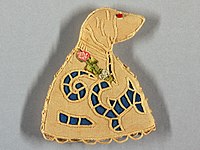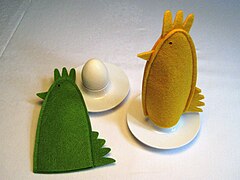Egg warmers

An egg warmer (also known as an egg hood or egg cone ) is a small hood for keeping a cooked egg warm ("breakfast egg"). For use, the egg - cooked in its shell - is usually placed in an egg cup before the hood is pulled over.
Egg warmers are mostly made of textiles , some of them plastic . There are also various types of warming containers for several eggs.
history
Similar to the egg cups, which came into fashion in aristocratic circles from the 16th century and later also reached upper-class households, special containers for keeping boiled eggs warm were also part of the representative table decorations from the end of the 18th / beginning of the 19th century. They were usually elaborately designed and the eggs were kept warm by pouring hot water into them. Today they are a collector's or museum item; For example, several splendid examples from France from around 1810 belong to the holdings of the Cooper Hewitt Museum of Applied Arts , Smithsonian Design Museum in New York City.
Around the end of the 19th century, egg hoods appeared for individual eggs, which were initially made by hand from fabric and / or yarn and often artistically sewn, crocheted or embroidered. As a result, they were also knitted, and the decorative and at the same time practical table accessory soon reached middle-class households. In 1922, for example, the family and entertainment paper at the time, Die Gartenlaube, described “cute crocheted egg warmers” and provided instructions for making it yourself.
When plastic articles became the trend in the late 1960s / early 1970s, various egg warmers made of “plastic” and with a “Styrofoam” inner shell came on the market. Such “modern designer egg warmers” were part of the consumer goods range of the Tchibo branches in 1971, for example .
The commercial range of egg warmers made from textiles was initially rather manageable and can now be found in department stores and at various mail order companies as well as in well-stocked kitchen equipment and gift shops, and often as seasonal goods for Easter. In contrast, handcrafted textile egg warmers can often be found in bazaars and handicraft sales exhibitions, etc.
In the course of the commercialization and spread of the Internet at the beginning of the 21st century, new marketing opportunities for "homemade" products developed. Online marketplaces for the buying and selling handmade products such as the E-Commerce - Website Etsy or set in August 2018 German portal about were increasingly for " amateur or hobby manual laborers attractive" because they enabled broad customer contacts and an uncomplicated form of distribution. In the meantime, there is also a diverse range of "homemade egg warmers" in all shapes, materials and colors on the relevant portals.
Today, egg warmers are generally regarded as the “current trend accessory on the breakfast table” and as “funny” and mostly inexpensive gifts and souvenirs, which can also be made “child's play” and quickly as an alternative to the usual purchase offer. They are popular handicrafts for all ages as they require few materials and simple craft, crochet, sewing, embroidery or knitting skills to make. Egg warmers are among the handicrafts and design work that is often offered in kindergartens and day-care centers as well as in school art lessons in primary school , but can also often be found in handicraft groups in meeting places and retirement homes .
Types
Egg warmers made from textiles
Egg warmers made from textiles in the form of small hoods that are placed over a single boiled egg to keep them warm are the most common. The material used for the hoods is yarn , fabric or felt . Usually they are equipped with heat-insulating linings or intermediate layers made of fabric, foam or wadding . Depending on the textile material used, they are made - mostly by hand - by felting , crocheting , sewing , embroidery or knitting .
In addition to the usual trade offer, they are also a popular handicraft and handicraft item for all ages and there are numerous handicraft instructions for them. The shape and inner size of the “warming area” are based on the sizes of chicken eggs that are common today; In addition, there are no limits to imagination and creativity: the palette ranges “from trendy to romantic and from modern to playful”. Often they are also provided with small applications such as buttons , bows or similar to taste. There are also motifs for every season, with “ Easter egg warmers” in particular being favorites.
Set of knitted egg warmers (New Zealand, 1950/1960)
Egg warmer ( wet felted )
" Easter egg warmers" (sewn from needle felt)
Plastic egg warmers
In addition, some egg warmers made of plastic such as thermoplastic or duroplastic are available in stores , in which the integrated lower part also serves as an egg cup. They are egg-shaped, have a flattened base and are equipped with a heat-insulating insert made of polystyrene ("Styrofoam"). Alternatively, there are so-called “thermal egg cups”, which are made of double-walled plastic with an insulating layer of air in between.
Food-safe silicone is now also used as the plastic material for the upper and lower parts , and there are also sets consisting of a specially designed porcelain egg cup and a matching silicone cap.
Warming container for several eggs
Containers for keeping multiple boiled eggs warm come in different types, sizes, and materials. In einfachster form they consist of a woven wood basket or other suitable container with one or more napkins or a dishcloth is padded and covered. They belong to the "standard" for breakfast buffets in hotels and restaurants. In addition, there are so-called “egg baskets” made of willow or polypropylene with a padded inner lining made of fabric, with which up to 20 eggs can be kept warm.
For domestic use there are special sets on the market, which consist of a small basket made of woven willow or partly of fabric and which are equipped with a textile lining. They are usually designed for common household quantities of 4 or 6 eggs. The boiled eggs are placed in small padded pockets; the inner lining is divided accordingly. There are also sewn cloth bags with a thermal liner for around 10–12 eggs. The "egg warmer baskets" are also a popular handicraft item.
There are also special warming containers made of porcelain or ceramic , which are equipped with a lid made of the same material and which, in most cases, illustrate their function through their design - for example as a “stylized brooding chicken ”. Before the ready-boiled eggs are placed in them, they are filled with hot water.
reception
From a cultural-sociological point of view, egg warmers are in part attributed to everyday design ; however, the boundaries to kitsch are fluid. For example, various egg warmers were shown in the exhibition “Geliebter Kitsch or the roaring deer in the showcase”, which was on view in the Bonn Central Library in 1982 . Several dozen Bonn citizens had previously answered a call from the library and had contributed numerous, in their opinion kitsch, exhibits to the exhibition: "From the South Sea landscape in the snow to egg warmers, corkscrews and shoehorns in grotesque presentation to the inevitable garden gnome." Everyday culture, egg hoods and warming baskets are shown in museums such as the GDR Museum Berlin in Berlin-Mitte, the Werkbundarchiv - Museum der Dinge in Berlin-Kreuzberg, the Textile and Racing Museum in Hohenstein-Ernstthal in Saxony or the Schleswig-Holstein open-air museum in Molfsee near by Kiel.
The journalist, literary critic, writer and language critic Thomas Steinfeld used the term “egg warmer” in a criticism of the willingness of Germans to use foreign words published in 2002 as a metaphor for “making oneself small” and the “lack of ( Language) loyalty "of the Germans:" Apparently you just have to hum words like 'service center' or 'mail' [...], and the short-legged egg warmers disguised as Germans throw themselves over with enthusiasm. "

The artist Cora Fisch , who is particularly known for her works of art made of discarded fur clothing , created a series of fur egg warmers in 2006. Her work “Das Ei im Pelz” / Hommage à Meret Oppenheim was shown in 2006 in the museum shop of the then Kunsthalle Deutsche Guggenheim in Berlin as an Easter installation and also offered as an egg warmer edition .
The media and communication scientist Dagmar Hoffmann ( University of Siegen ) dealt in an article published in a specialist journal in 2013 with the online marketing of “self-made” and the “ contingency of the aesthetic ” in self-made products. They situate on online sites like Etsy numerous offered homemade Eierwärmer between " Häkeltischdeckchen and toilet roll hats " - "Design beside trash" [...] "in the midst of Oddities and trinkets ".
literature
- Anke Sturm (Ed.): Egg warmer. Original ideas & modern designs in a mix of materials . OZ Verlag, Rheinfelden 2006, ISBN 3-89858-813-0 .
- Susanne Schaadt: Egg warmer. Nice ideas for post-crochet . OZ creativ, Freiburg im Breisgau 2013, ISBN 978-3-8410-6206-2 .
- Susanne Schaadt: Egg warmer. Ideas for knitting and felting . OZ creativ, Freiburg im Breisgau 2014, ISBN 978-3-8410-6274-1 .
- Pia Pedevilla: Happy eggs. Funny egg warmers made of felt. Over 40 motifs for the whole year . Frechverlag, Stuttgart 2016, ISBN 978-3-7724-4190-5 .
Web links
- Egg warmers . In: haus.de (various examples in the form of handicraft instructions)
Individual evidence
- ↑ Egg warmers. In: The Gazebo . 1922, p. 587.
- ^ See: Advertisement from Tchibo in the Bunter ; Burda Verlag, 1971, p. 199.
- ↑ See: Easter bazaar in the local museum . In: wn.de. Westfälische Nachrichten , March 13, 2017.
- ↑ a b c Dagmar Hoffmann: The contingency of the aesthetic and the social arrangements of artists, designers and amateurs on the Internet. In: Psychology and Social Criticism . Volume 37, Issue 2 (No. 146), 2013, ISSN 0170-0537 , pp. 91–112.
- ↑ a b c See: Anke Sturm (Ed.): Eierwärmer. Original ideas & modern designs in a mix of materials. Rheinfelden 2006.
- ↑ See: Susanne Schaadt: Egg Warmer. Ideas for knitting and felting. Freiburg im Breisgau 2014.
- ↑ See: Rosemarie Schmidt: Textiles Gestalten in the primary level: 10th edition. Persen, Horneburg 2007, ISBN 978-3-8344-2083-1 , no.11.
- ↑ Gaby Kiedaisch: At Easter, the city museum is colorful. In: Wendlinger Zeitung . March 14, 2011 ( full text on deutsches-eierbechermuseum.de).
- ↑ See: Stephan Moebius , Sophia Prinz (Hrsg.): Das Design der Gesellschaft. On the cultural sociology of design. Transcript, Bielefeld 2012, ISBN 978-3-8376-1483-1 .
- ↑ Bonn. In: Buch und Bibliothek , Volume 34, Issues 1-5, 1982, p. 212; as well as in volume 38, issues 6-12, 1986, p. 812.
- ↑ DDR Museum Berlin: Eierwärmer .
- ^ Werkbundarchiv - Museum der Dinge: Egg warmer .
- ↑ museums North: Eierwärmer .
- ↑ Thomas Steinfeld : Animal life in the polar sea: In: Deutsche Welle (Hrsg.): Passé and mega-out? On the future of the German language in the age of globalization and multimedia. Vistas, Berlin 2002, ISBN 3-89158-329-X , p. 14 ff.
- ↑ See Cora Fisch's homepage : Guggenheim Shop - The egg in fur . In: corafisch.de, 2006.






